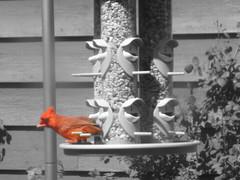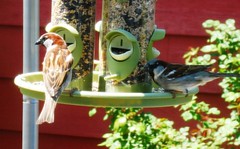Monday, May 26, 2008
Breaking News:Hailstorm
Posted by
Matthew S
at
6:58 PM
0
comments
![]()
Labels: gardening 2008, hail, severe weather
Garden Update: Bio-diversity?
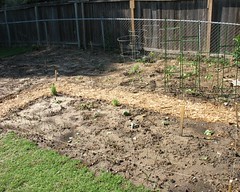 Took these pictures yesterday. The large overview picture makes it hard to tell just how much everything has grown from the earlier picture but when you are standing or if you look at the picture under all sizes, original size you can tell how much bigger the pictures are getting.
Took these pictures yesterday. The large overview picture makes it hard to tell just how much everything has grown from the earlier picture but when you are standing or if you look at the picture under all sizes, original size you can tell how much bigger the pictures are getting.
The other thing that you can see is where I put in the mulch based path. This will allow us to get in and inspect the garden with kids in tow and not have up to 6 sets of mud covered feet to deal with. It was really a great visual indicator for me to plan out different blocks of the garden. 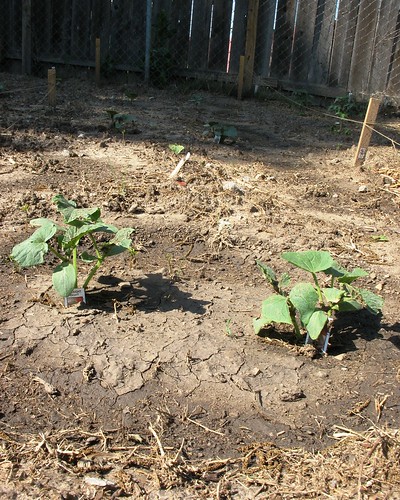 I had thought about having more paths but I consolidated down to a simple "L" shape. The path starts on grass and ends at the compost pile.
I had thought about having more paths but I consolidated down to a simple "L" shape. The path starts on grass and ends at the compost pile.
This is the west side of the mulch path, the cucumber bed. My goal is to vine these cucumbers over the top of each other providing for some shade and protection when August gets here and hopefully extending the harvest season. I haven't decided if I am going to get any trellis to let them climb onto or not or if I will just use the chain-link in the back.
If you look to the right of the 2 wooden stakes that is the beginning of the area above the mulch path in the top picture. That part of the garden contains 7 bell peppers, 10 tomatoes and 3 eggplants. To the right you can see the onions that are coming up. I bought two bundles of Yellow Texas sweet sets. They are taking off, getting big and starting out new leaves of their own.
Directly behind the onions you can see one of the two dill plants. This one has grown about 2 inches since i planted it just about 1 week ago. On the right hand sid of the picture you can see some of the other herbs growing but it is hard to see them clearly but they are getting bigger as well. As they get a bit bigger I am going to take some of the information from here and other stuff we have learned and try to highlight each one.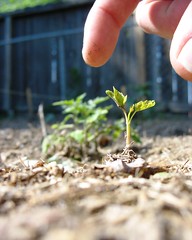 Now, as to the whole question of bio-diversity that I mentioned in the title of the blog. Bio-diversity in a garden or a yard is nice way of saying that I have weeds. I am using my grass as mulch instead of putting it directly back onto the lawn or bagging it and throwing it away. The only problem is that my grass, Bermuda, isn't quite growing quick enough for me to have enough clippings to have most of the area in the garden that needs covering covered. The neighbor's maple tree also released thousands of those fun to play with helicopters and they ended up in my garden as well. So, every now and then I have to pull one up out of the ground.
Now, as to the whole question of bio-diversity that I mentioned in the title of the blog. Bio-diversity in a garden or a yard is nice way of saying that I have weeds. I am using my grass as mulch instead of putting it directly back onto the lawn or bagging it and throwing it away. The only problem is that my grass, Bermuda, isn't quite growing quick enough for me to have enough clippings to have most of the area in the garden that needs covering covered. The neighbor's maple tree also released thousands of those fun to play with helicopters and they ended up in my garden as well. So, every now and then I have to pull one up out of the ground.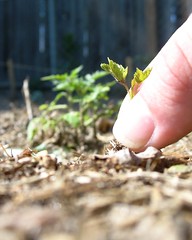 It isn't that I have something against trees because they are trees but because I don't want a tree in the middle of my garden. Everything has its place and we must tend to our gardens as we tend to our lives. If something in our lives is keeping our garden from growing, be it a weed, hobby, or the shift of our job we have to pluck it out and start anew. This is what St. Therese was talking about when she asked, "How does your garden grow?" I remember reading Story of a Soul and Voltaire's Candide and comparing their ideas in college. They both used the image of a garden.
It isn't that I have something against trees because they are trees but because I don't want a tree in the middle of my garden. Everything has its place and we must tend to our gardens as we tend to our lives. If something in our lives is keeping our garden from growing, be it a weed, hobby, or the shift of our job we have to pluck it out and start anew. This is what St. Therese was talking about when she asked, "How does your garden grow?" I remember reading Story of a Soul and Voltaire's Candide and comparing their ideas in college. They both used the image of a garden.
The other person that talks about gardening alot in philosophy is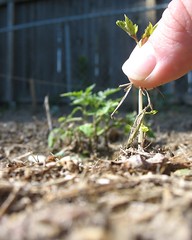 Kiekegard. Right now in my life I am looking really closely at how my garden grows and the past week has been a blessing. I see a few weeds and maybe even a shade tree or two blocking the sun. I think some weeding or at least some pruning is in order.
Kiekegard. Right now in my life I am looking really closely at how my garden grows and the past week has been a blessing. I see a few weeds and maybe even a shade tree or two blocking the sun. I think some weeding or at least some pruning is in order.
Under the Mercy,
Matthew S.
Posted by
Matthew S
at
8:48 AM
1 comments
![]()
Labels: cucumbers, garden veggies, gardening 2008, herbs, onion
Sunday, May 25, 2008
Herb Garden Notes, harvesting and drying
Notes for the Herb portion of the garden.
http://ohioline.osu.edu/hyg-fact/1000/1612.html
Basil
Basil, French basil, or sweet basil (Ocimum basilicum) is a popular, tender, annual herb. It is native to India and Asia. Basil is grown for its aromatic leaves which are used fresh or dried as a flavoring. Fresh basil leaves are used in tomato sauces and pesto sauces. Basil is also good with veal, lamb, fish, poultry, white beans, pasta, rice, tomatoes, cheese, and eggs. It can also be used in vinegar and tea.
Basil can be direct-seeded or transplanted to the garden in late spring, after all danger of frost is past. Basil seeds normally germinate in 8-14 days. Basil requires full sun and prefers moist and well-drained soil with a pH of 6.0. Typical spacing for basil is 12 inches between plants, and 24 to 36 inches between rows.
Basil grown for dried leaves or essential oil is cut just prior to the appearance of flowers. The foliage should be cut at least four to six leaves above the ground to allow for regrowth and a subsequent crop (Figure 2). Information on insects and diseases of basil is limited. Japanese beetle, Fusarium, and powdery mildew have been reported to attack basil. Refer to OSU Extension Fact Sheet HYG-1644-94 for additional information on basil.
Dill
Dill, Anethum graveolens, is native to the Mediterranean area and southern Russia. Dill is a hardy annual, and sometimes is grown as a biennial. Dill is commonly used as a seasoning for soups, fish, and pickles. Its aromatic leaves, seeds, flowers, and stems can be used to flavor cabbage, vinegars, butter, apple pie, butter, cakes, and bread. Dill should be direct-seeded in spring, at a 10-inch spacing. Since dill has long tap roots, it should not be transplanted. Fresh leaves should be harvested before flowering begins. Harvest seeds as soon as seed heads are brown and dry. Dill is a great plant in butterfly gardens since butterfly larvae feed on dill. Dill does not have any serious pest or disease problems. However, phoma blight, rusty root, and stem rot have been reported.
Oregano
Oregano, Origanum vulgare subsp. hirtum also referred to as O. heracleoticum and O. hirtum, is native to the Mediterranean region of Europe and central Asia. It is naturalized in the eastern United States. It is used in tomato sauce to add a hot and peppery taste. It adds dimension to yeast breads, marinated vegetables, roasted meats, and fish. Oregano is a perennial, and can be propagated by seeds. Direct seed in the garden and do not cover seeds since they need sunlight to germinate. Flavor can vary a lot among seed propagated plants. It is better to propagate by root divisions or cuttings from plants that are known to have strong flavor. Oregano reaches a height of 12-24 inches, and a width of 10-20 inches. It requires a site with full sun, and well-drained soil with a pH of 6.8. Sprigs of oregano can be cut off when the plant is at least 6 inches high. In June, vigorously grown plants can be cut back to the lowest set of leaves. Plants will generally leaf out after two weeks and can be cut back again in August. Some pest and disease problems for oregano include aphids, leafminers, spider mites, and root rot.
Rosemary
Rosemary, Rosmarinus officinalis, is a tender perennial, hardy to zones 8 to 10. It is native to the Mediterranean region, Portugal, and northeastern Spain. It is pungent, somewhat piny, and mintlike yet sweeter. Its flavor harmonizes with poultry, fish, lamb, beef, veal, pork, and game. Rosemary also enhances vegetables, cheese, and eggs. Rosemary can be started from seeds, but germination rates are very low. Use fresh seeds, preferably less than two weeks old. Packaged seeds are difficult to germinate. Start plants from cuttings or by layering from existing plants. Rosemary grows slowly from seeds, and eventually reaches a height of 72 inches and a width of 36-72 inches. Plant rosemary in a sunny location with well-drained, slightly acidic soil. Harvesting can be done throughout the year. Cut 4-inch pieces from the tips of the branches, being careful not to remove more than 20% of the growth at one time. Pest and disease problems of rosemary include aphids, spider mites, scale, mealybugs, root rot, and botrytis.
http://www.lesleycooks.com/herbs.htm
A=Annual B=Biennial P=Perennial TP=Tender perennial
Basil, Sweet-(A)- For fresh use, harvest the leaves as they mature-about 2 weeks after planting. For dry use, harvest leaves just before the plant blooms. Use: One of the most popular herbs, used mainly with tomato and egg dishes, stews, soups, and salads, but also with many vegetable, poultry, and meat dishes.
Dill-(A)- The fresh leaves can be harvested as needed and used as seasoning. Seed heads should be harvested then the seeds ripen to a light brown color. Uses: Leaves and seed heads are most commonly used in the making of dill pickles. The leaves also add a characteristic flavor to salads, cottage cheese, soups, fish dishes, omelets, sauces, and vegetable casseroles. Dill seeds are sometimes used in pastries, sauces, sauerkraut dishes, and for flavoring vinegar.
Oregano-(P)- Harvest and dry before flowering occurs. Uses: Oregano imparts a sharper flavor than Sweet Marjoram. It is used to season spaghetti sauces and tomato dishes. Its flowers are attractive in summer arrangements.
Rosemary-(TP)- Harvest the young, tender stems and leaves, but avoid taking off more than one-third of the plant at one time. For drying, harvest just before the plant flowers. Uses: A gourmet seasoning for meats, poultry dishes, and potatoes. Use either fresh or dried.
http://hgic.clemson.edu/factsheets/HGIC3086.htm
Dehydrator Drying
Dehydrator drying is a fast and easy way to dry high quality herbs because temperature and air circulation can be controlled. Pre-heat dehydrator with the thermostat set to 95 °F to 115 °F. In areas with higher humidity, temperatures as high as 125 °F may be needed. After rinsing under cool, running water and shaking to remove excess moisture, place the herbs in a single layer on dehydrator trays. Drying times may vary from one to four hours. Check periodically. Herbs are dry when they crumble, and stems break when bent. Check your dehydrator instruction booklet for specific details.
Air Drying
Sturdy Herbs: Herbs such as sage, thyme, summer savory and parsley are the easiest to dry. They can be tied into small bundles and air-dried. Air-drying outdoors is often possible; however, better color and flavor retention usually results from drying indoors.
Tender-Leaf Herbs: Basil, tarragon, lemon balm and the mints have a high moisture content and will mold if not dried quickly. Try hanging the tender-leaf herbs or those with seeds inside paper bags to dry. Tear or punch holes in the sides of the bag. Suspend a small bunch (large amounts will mold) of herbs in a bag and close the top with a rubber band. Place where air currents will circulate through the bag. Any leaves and seeds that fall off will be caught in the bottom of the bag.
Oven Drying
Another method — especially nice for mint, sage or bay leaf — is to dry the leaves separately. In areas of high humidity, it will work better than air drying whole stems. Remove the best leaves from the stems. Lay the leaves on a paper towel, without allowing leaves to touch. Cover with another towel and layer of leaves. Five layers may be dried at one time using this method. Dry in a very cool oven. The oven light of an electric range or the pilot light of a gas range furnishes enough heat for overnight drying. Leaves dry flat and retain a good color.
Microwave Drying
Microwave ovens are a fast way to dry herbs when only small quantities are to be prepared. Follow the directions that come with your microwave oven.
This website has all kinds of stuff about Cuban Oregano, including a recipes.
Much more stuff from a scientific level on oregano.
Sunday, May 18, 2008
My Garden, It's Planted (Pictures)
Under the Mercy,
Matthew S
Posted by
Matthew S
at
4:02 PM
0
comments
![]()
Happy Birthday Lucia
Posted by
Matthew S
at
10:02 AM
0
comments
![]()
Thursday, May 8, 2008
Happy Birthday Anna!
Under the Mercy,
Matthew S
Posted by
Matthew S
at
11:59 AM
0
comments
![]()
Sunday, May 4, 2008
My Daughters at the Prairie Rose Chuckwagon Opera House
This is their first ever stage performance, very impromptu. One of the hands that supper heard about my daughters and had them sing for her in the gift shop, next thing I know they are on stage with one of the Prairie Rose Rangers. Small attack of stage fright but all went well. Daddy is so proud. Hmmm, my oldest wants violin lessons, wonder if she could just take fiddle lessons?
Here they are singing Happy Trails the song made famous by Roy Rogers and Dale Evans, who are incidentall my daughter's heroes. More pictures to come but I have to edit them.
Under the Mercy,
Matthew S
Posted by
Matthew S
at
10:34 AM
1 comments
![]()
Thursday, May 1, 2008
Bird Feeder Visitor: This would be a boy Cardinal
Posted by
Matthew S
at
1:04 PM
0
comments
![]()
Bird Feeder Visitor: House Sparrow
Under the Mercy,
Matthew S
Posted by
Matthew S
at
9:55 AM
1 comments
![]()





